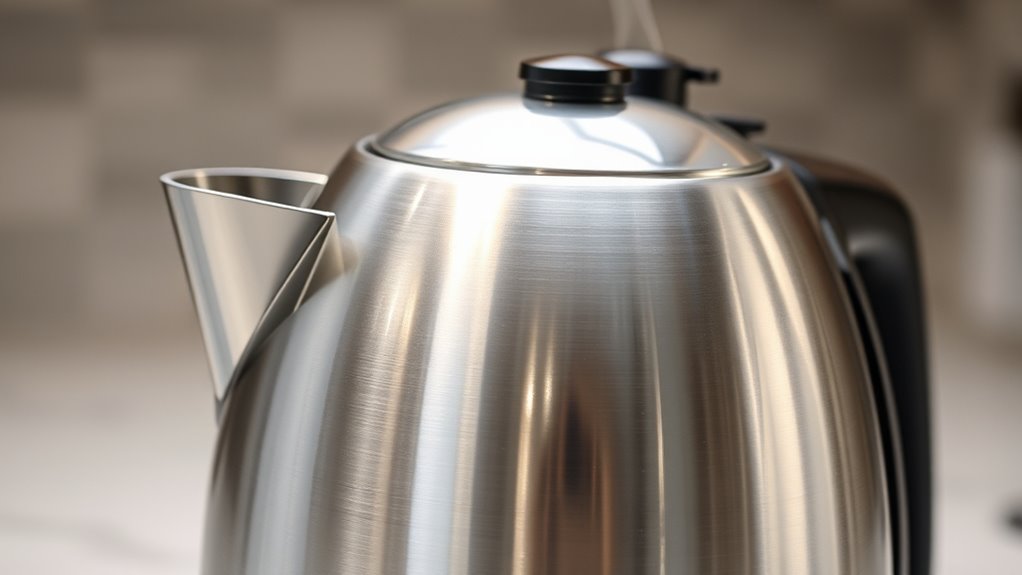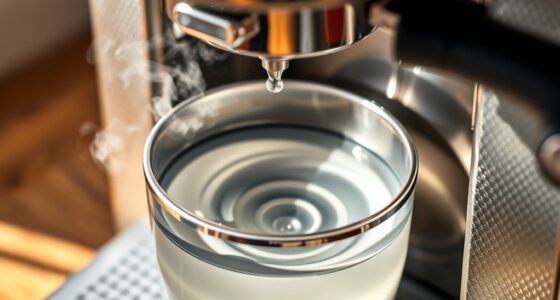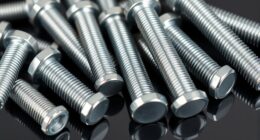If your electric kettle tastes metallic, it’s likely due to mineral buildup or corrosion inside. To fix this, you should clean it with a vinegar or lemon water solution by boiling and then rinsing well. Regular descaling and using filtered water can prevent future off-flavors. If the problem persists, check for damaged parts or buildup on the element. Keep going for detailed steps to restore fresh, clean water flavor.
Key Takeaways
- Clean the kettle with a vinegar or lemon solution to remove mineral buildup causing off-flavors.
- Regularly descale the kettle using equal parts water and vinegar or descaling agents.
- Inspect and replace any corroded or damaged parts, like heating elements or switches.
- Use filtered or distilled water to minimize mineral deposits and prevent metallic tastes.
- Rinse thoroughly after cleaning to eliminate residual odor and taste, ensuring fresh water flavor.
Identifying the Causes of a Metallic Taste in Your Kettle
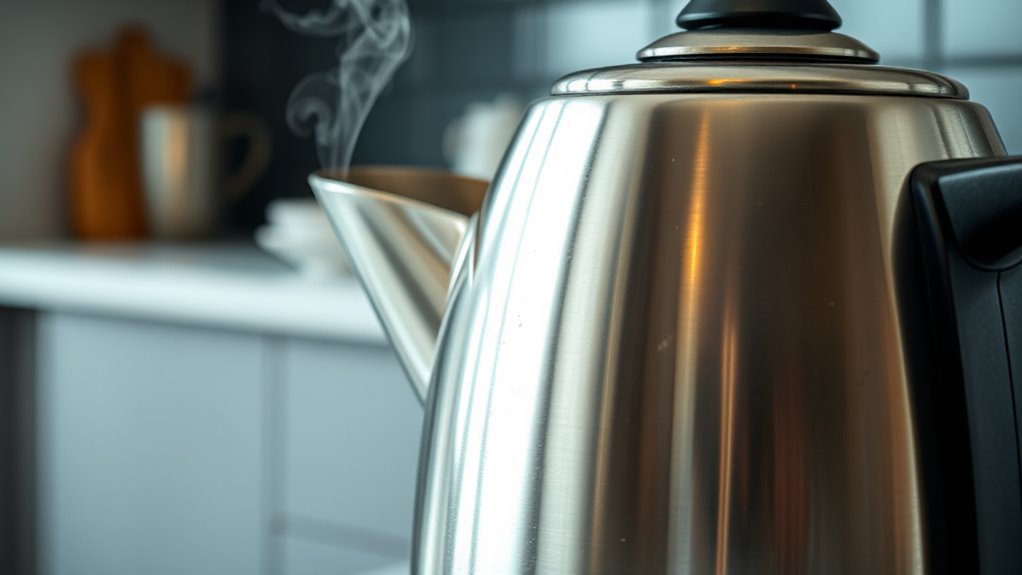
A metallic taste in your kettle often signals underlying issues that need attention. One common cause is poor water quality, which can introduce minerals and impurities that react with the metal inside your kettle. Over time, mineral buildup can accelerate metal corrosion, especially if your water is highly acidic or contains high levels of certain minerals. Metal corrosion occurs when the protective layer on the kettle’s interior deteriorates, exposing raw metal to water, which then leaches into the water and causes that off-putting metallic flavor. If you notice a persistent metallic taste, consider testing your water quality and inspecting your kettle’s interior for signs of corrosion or mineral deposits. Addressing these issues early helps prevent further damage and keeps your water tasting fresh. Additionally, automation in business advancements can be utilized to monitor and maintain water quality standards in commercial settings.
Cleaning Your Electric Kettle With Vinegar or Lemon
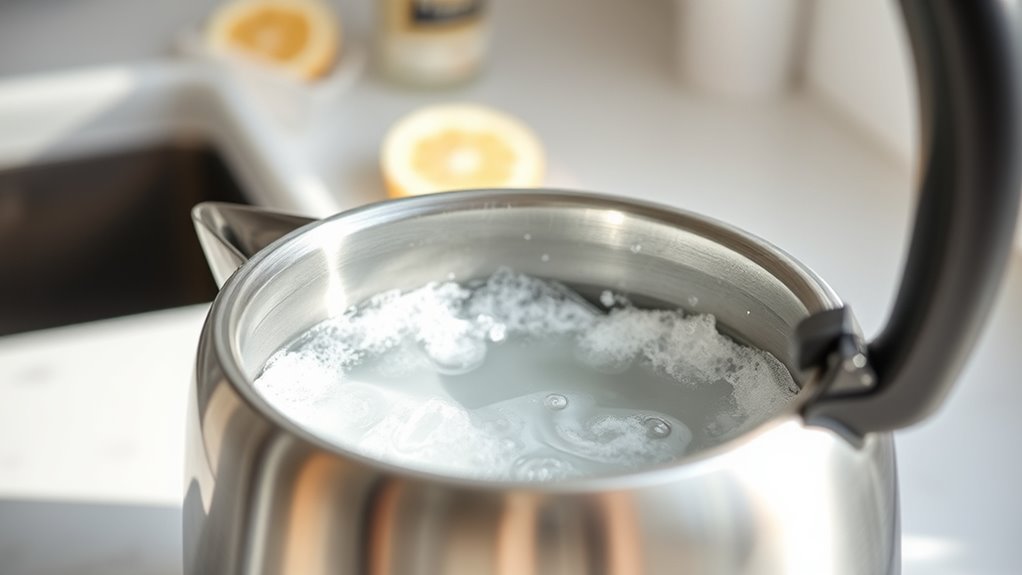
To restore your kettle’s fresh taste, regular cleaning with natural agents like vinegar or lemon juice can be highly effective. These options work well with stainless steel kettles to eliminate off-flavors caused by water quality issues. Fill the kettle with equal parts water and white vinegar or lemon juice, then bring it to a boil. Let it sit for 15-20 minutes to loosen mineral deposits and residues that can cause metallic tastes. Afterward, discard the solution and rinse thoroughly with clean water. For a fresh scent, run a second rinse cycle with plain water. This simple process helps keep your stainless steel kettle clean, neutralize off-flavors, and improve water taste, especially when water quality varies. Regular maintenance guarantees your kettle remains fresh and free of unwanted metallic notes. Monitoring pinball machine weight can also be important if you plan to move or install your appliance in different locations, ensuring safety and stability.
Removing Mineral Buildup With Descaling Solutions
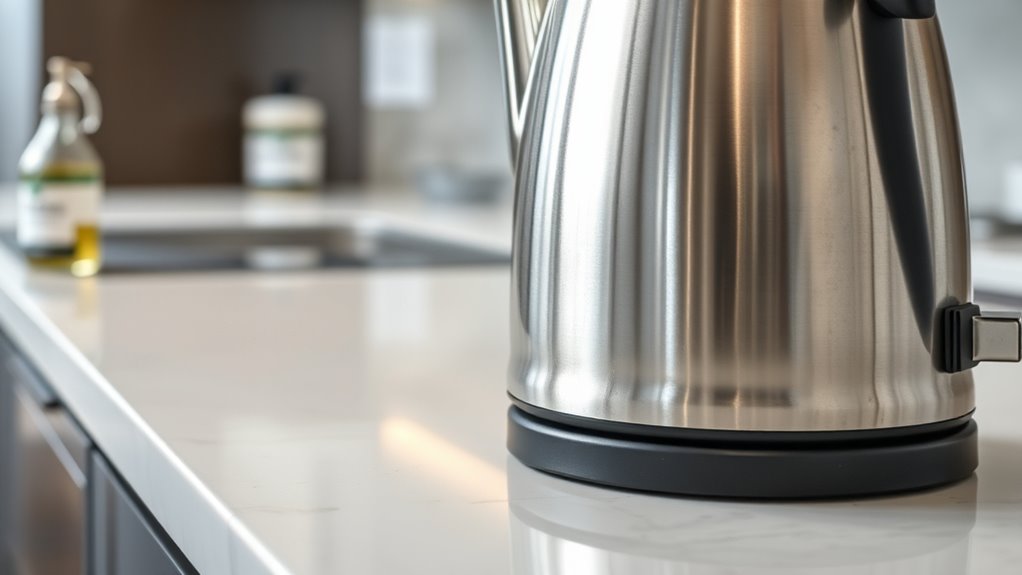
Mineral buildup in your electric kettle can compromise its performance and affect the water’s taste. To combat this, descaling solutions are effective, especially if you’re concerned about water quality or your kettle’s material. Here’s how to do it:
Regular descaling removes mineral buildup, restoring kettle performance and improving water taste.
- Fill your kettle with equal parts water and white vinegar or a commercial descaler designed for kettles.
- Turn it on and let the solution boil, then turn off and let it sit for 15-20 minutes.
- Empty the kettle and scrub any remaining deposits gently with a non-abrasive brush.
- Rinse thoroughly with fresh water to remove residue, ensuring no flavor or vinegar smell remains.
This process helps remove mineral buildup, restoring your kettle’s efficiency and improving water taste regardless of your kettle material.
Checking and Replacing Old or Damaged Parts
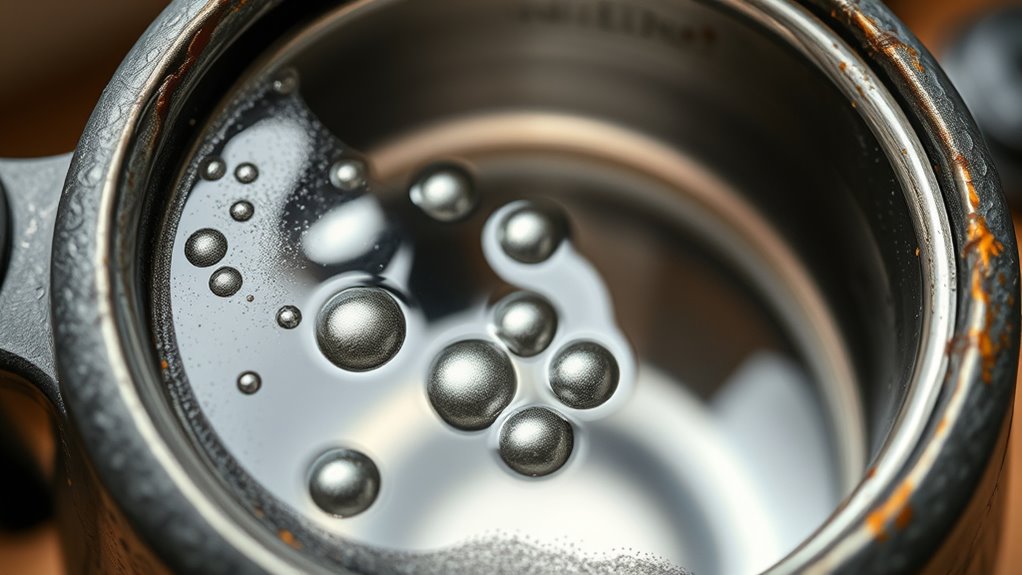
Regularly inspecting your electric kettle for worn or damaged parts is essential to maintaining ideal performance and preventing off-flavors. Start with circuit inspection to spot frayed wires or corrosion that could affect the power supply. Check the power cord and plug for damage, ensuring a secure connection. If you notice any issues, replace faulty parts promptly to avoid further damage or off-flavors caused by electrical problems. Use the table below to guide your inspection:
| Part | What to Check | Replacement Needed |
|---|---|---|
| Power cord and plug | Fraying, cracks, loose connections | Yes |
| Heating element | Mineral buildup, corrosion | Yes |
| Switch or control knob | Loose or stuck components | Yes |
| Circuit board | Signs of damage or corrosion | Yes |
Maintaining these parts ensures your kettle functions smoothly and tastes fresh. Properly checking electrical components can also help prevent potential hazards.
Preventing Future Off-Flavors and Maintaining Your Kettle
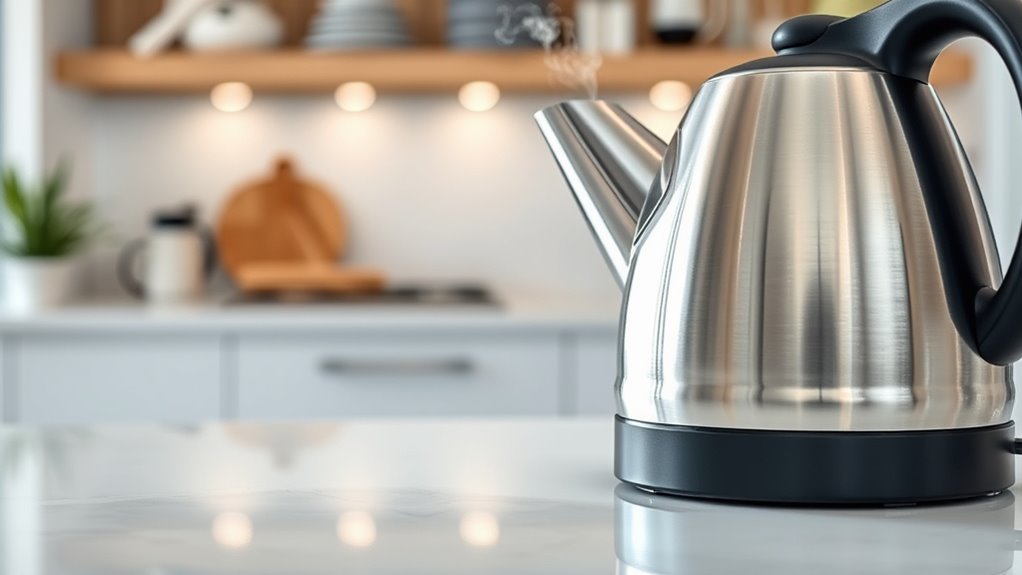
Ensuring your electric kettle stays free of off-flavors requires consistent maintenance and mindful use. To achieve effective flavor prevention and maintain the best taste, follow these steps:
- Regularly descale your kettle to remove mineral buildup that can cause off-flavors.
- Use filtered or distilled water to reduce impurities and prevent taste contamination.
- Clean the kettle interior weekly with a mixture of vinegar and water for ongoing taste maintenance.
- Avoid leaving water inside for long periods to prevent stagnation and flavor changes.
Frequently Asked Questions
Can Using Filtered Water Reduce Metallic Tastes in My Electric Kettle?
Yes, using filtered water can reduce the metallic taste in your electric kettle. Filtered water removes minerals and impurities that often cause off-flavors, including metallic notes. By switching to filtered water, you’ll notice a cleaner, fresher taste in your boiled water. Regularly descaling your kettle also helps, but filtered water is an effective way to prevent metallic flavors from developing in the first place.
How Often Should I Descale My Kettle to Prevent Off-Flavors?
Think of your kettle like an old-time clock—if you ignore its maintenance, it’ll jam. You should descale your kettle every 3 to 4 weeks, especially if you notice mineral buildup. Regular descaling prevents off-flavors and keeps the metallic taste at bay. If you use hard water, consider descaling more often. Proper maintenance guarantees your kettle stays clean, efficient, and free of unwanted tastes.
Are There Specific Brands of Descaling Solutions Recommended for Kettles?
When choosing descaling solutions, look for trusted brands like Dezcal, Durgol, or Krups, known for their descaling effectiveness. These brands are formulated to remove mineral buildup without damaging your kettle, ensuring better taste. Always follow the manufacturer’s instructions for proper use. Using recommended brands helps prevent off-flavors caused by mineral deposits, keeping your kettle clean and your water tasting fresh.
Is It Safe to Use Lemon Juice or Vinegar Frequently for Cleaning?
Using lemon cleaning or vinegar safety for your kettle is generally safe if you use them in moderation. Lemon juice and vinegar effectively remove mineral buildup and neutralize off-flavors, but frequent use can corrode your kettle’s interior or affect its lifespan. Always dilute vinegar or lemon juice with water, and rinse thoroughly afterward. This guarantees your kettle stays clean, safe, and free from metallic tastes without risking damage.
What Are Signs That My Kettle’s Parts Are Nearing the End of Their Lifespan?
Ever notice your kettle taking longer to boil or making strange noises? These signs point to part deterioration, indicating your kettle’s lifespan is nearing its end. Cracks, rust, or a persistent metallic taste also signal impending failure. Don’t ignore these clues—regularly inspect your kettle for corrosion or damage. When these signs appear, it’s time to think about replacing parts or the entire kettle to guarantee safety and ideal performance.
Conclusion
Don’t let a metallic taste ruin your tea or coffee. Regular cleaning with vinegar, lemon, or descaling solutions keeps mineral buildup at bay and guarantees your kettle stays fresh-tasting. Some might think replacing parts is costly, but it’s a small investment compared to constantly discarding bad-tasting water. With proper maintenance, you’ll enjoy clean, great-tasting beverages every time—no more off-flavors, just pure enjoyment. Keep your kettle in top shape and savor every sip!
